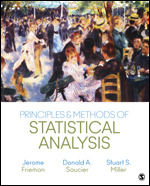How to Construct a Stem-and-Leaf Display
Purpose:
To provide a representation of all of our data which is both a graph and a table.
Procedure:
Rank order the data.
Choose a pair of adjacent digit positions to split all numbers in the data set into stems and leafs. For example, the number 623 can be split into 62 3 or 6 2 (throwing away the 3). In that case, 62 is the stem and 3 is the leaf. In the second case, 6 is the stem and 2 is the leaf. The choice of where to place this split is governed by how the final display looks. Sometimes we may have to compare different stem/leaf splits to find the one that creates the most informative display.
Create a column of all of the possible stems from lowest to highest in the present data set.
Draw a vertical line to separate the stems from the leaves. Locate the stem for each number and write the leaf (first trailing digit) on that stem line. The leaves should be arranged in ascending order on each stem.
When there are a large number of values, two or more lines can be used per stem. The two most commonly used arrangements are two lines per stem and five lines per stem. The choice of how many lines to use per stem is also dictated by how the final display looks.
a. Two lines per stem: Place leaves 0, 1, 2, 3, and 4 on the first line (indicated by a ∙ after the stem), and leaves 5, 6, 7, 8, and 9 on the second line (indicated by a * alone).
b. Five lines per stem: Place leaves 0 and 1 on a line labeled ∙, leaves 2 and 3 on a line labeled T (Two and Three), leaves 4 and 5 on a line labeled F (Four and Five), leaves 6 and 7 on a line labeled S (Six and Seven), and leaves 8 and 9 on a line labeled *.
6. Extreme outliers can be simply listed as LO and HI on each end of the distribution. Here use the entire number.
7. At the top of the display, indicate the unit of the leaf with a decimal point, and by providing an example such as in the case of 623 split as 6 2, Unit = 10 12 = 120
If the 62.3 were split as 62 3, the example would be, Unit = .1 1 2 = 1.2
8. Counting from each end, indicate to the left of each stem the total number of leaves from that line to the nearer end of the data set. These indicate the depths of the values on that line to the closest end of the data set. For the stem line that contains the median, count the number of leaves on the stem and put that number in parentheses. If the median fall between two lines, the depths of those two lines will be the same (and each will be half of the total sample size). Do not put a depth on a line that contains no leaves.

Statistical Analysis, by Jerome Frieman, intermediate/advanced statistics text, uses real research on antisocial behaviors, such as cyber-bullying, stereotyping, prejudice, and discrimination, to help readers across the social and behavioral sciences understand the underlying theory behind statistical methods. By presenting examples and principles of statistics within the context of these timely issues, the text shows how the results of analyses can be used to answer research questions.
